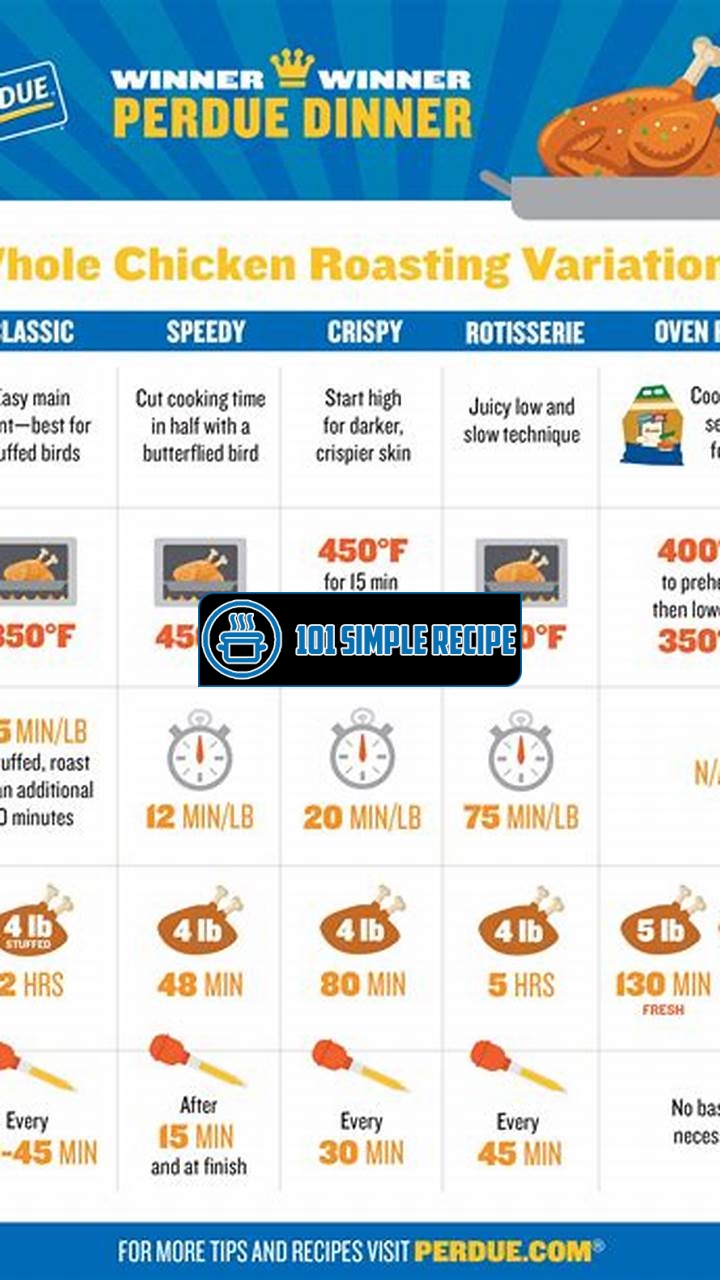Are you tired of overcooked, dry chicken? Look no further – with a few simple tricks, you can become a master at cooking chicken to perfection! In this article, we will guide you through the art of cooking chicken, sharing expert tips and techniques that will elevate your culinary skills to new heights. Whether you prefer crispy, juicy, or tender chicken, we’ve got you covered. So grab your apron, sharpen your knives, and get ready to impress your friends and family with mouthwatering chicken dishes. Let’s dive in and explore the secrets to cooking chicken like a pro!

The Importance of Cooking Chicken to the Correct Temperature
When it comes to cooking chicken, one of the most crucial factors for both food safety and incredible flavor is getting the temperature just right. Cooking chicken to the correct internal temperature ensures that harmful bacteria, such as salmonella, are killed, making it safe to consume. Additionally, proper cooking temperature ensures that your chicken is tender, juicy, and packed with flavor.
✅ The correct temperature for cooking chicken is essential to prevent foodborne illnesses and achieve mouthwatering results.
The Dangers of Undercooked Chicken
Undercooked chicken can pose significant risks to your health. Raw chicken can contain harmful bacteria like salmonella and campylobacter. Consuming undercooked chicken can lead to food poisoning, resulting in symptoms such as nausea, vomiting, diarrhea, and abdominal pain. In severe cases, it can even cause hospitalization or be life-threatening, especially for vulnerable populations like children, elderly, or individuals with weakened immune systems.
Furthermore, undercooked chicken not only poses health risks but also compromises the taste and texture of the meat. It may be chewy, unpleasantly slimy, and lacking in flavor.
The Ideal Internal Temperature for Chicken
️ To ensure that chicken is safe to eat and has the perfect texture, it is crucial to cook it to the appropriate internal temperature. The FDA recommends that chicken should reach an internal temperature of 165°F (74°C). At this temperature, any harmful bacteria present in the chicken will be destroyed, making it safe for consumption.
To measure the internal temperature, use a meat thermometer. Insert the thermometer into the thickest part of the chicken, avoiding contact with bones or the cooking pan. Once the thermometer shows a reading of 165°F (74°C), you can be confident that your chicken is thoroughly cooked and safe to eat.
Why It’s Important to Use a Meat Thermometer
❗ Using a meat thermometer is an essential tool for any chef or home cook. It takes away the guesswork and ensures precise cooking temperatures, guaranteeing both safety and delicious results.
A meat thermometer allows you to accurately measure the internal temperature of the chicken, taking into account variables such as size and thickness. This ensures that you achieve the optimal temperature for killing bacteria while keeping the meat tender and juicy.
Without a thermometer, it can be challenging to determine the doneness of the chicken accurately. Relying solely on visual cues, such as color or texture, can often lead to over- or undercooking, with potential health risks or compromised taste and texture.
Investing in a reliable meat thermometer is a small price to pay for the peace of mind and culinary success that comes with properly cooked chicken.
Remember, cooking chicken to the correct temperature is imperative for food safety and exceptional flavor. Don’t rely on guesswork – use a meat thermometer to ensure your chicken is cooked to perfection!
Factors Affecting Chicken Cooking Temperature
When it comes to cooking chicken, getting the temperature right is crucial for a perfectly cooked dish. There are several factors that can influence the cooking temperature, and understanding them will help you master the art of cooking chicken to perfection every time.
The Cut of Chicken
The cut of chicken you are using plays a significant role in determining the cooking temperature. Different cuts require different cooking times and temperatures to ensure they are cooked thoroughly. For example, bone-in chicken pieces such as thighs and drumsticks take longer to cook compared to boneless, skinless chicken breasts.
When cooking bone-in chicken pieces, it is essential to cook them at a higher temperature for a longer duration to ensure the meat is cooked through and the skin is crispy. On the other hand, boneless, skinless chicken breasts cook faster and can become dry if overcooked.
Brined or Marinated Chicken
Brining or marinating chicken before cooking can affect the cooking temperature and result in juicier and more flavorful meat. Brining involves soaking the chicken in a mixture of salt and water, which helps in tenderizing the meat and allowing it to retain moisture during the cooking process.
Marinating, on the other hand, involves soaking the chicken in a mixture of herbs, spices, and other ingredients to infuse flavor. Both brining and marinating can increase the cooking time slightly, as the chicken needs to reach the desired internal temperature while absorbing the flavors from the brine or marinade.
The Cooking Method
The cooking method you choose also affects the cooking temperature of chicken. Different cooking methods, such as grilling, baking, frying, or roasting, require varying temperatures to ensure the chicken is cooked thoroughly and safely.
Grilling chicken over direct heat requires a higher temperature to sear and cook the meat quickly. On the other hand, baking or roasting chicken in the oven requires a lower and more controlled temperature to ensure even cooking throughout.
Frying chicken in a skillet or deep fryer also requires a specific temperature to achieve a crispy and golden exterior while ensuring the meat is cooked through. It is important to use a cooking thermometer to monitor the oil temperature closely and adjust accordingly.
By considering the cut of chicken, whether it’s brined or marinated, and the cooking method you choose, you can determine the ideal cooking temperature for your chicken dish. Mastering the art of cooking chicken to perfection requires understanding these factors and adjusting accordingly to achieve delicious and tender results every time.
Tips for Cooking Chicken to the Correct Temperature
When it comes to cooking chicken, achieving the right temperature is crucial to ensure both safety and deliciousness. Here are some practical tips and techniques to help you master the art of cooking chicken to perfection.
Preheating the Oven
Before you even start cooking your chicken, it’s important to preheat your oven to the correct temperature. This ensures that your chicken cooks evenly and thoroughly. Set your oven to the recommended temperature according to the recipe or cooking instructions. Preheating the oven allows the chicken to start cooking immediately, preventing any potential foodborne illnesses caused by undercooked chicken.
Using the Correct Pan Size
The size of your pan plays a crucial role in cooking chicken to the correct temperature. It’s important to use a pan that is appropriate for the amount of chicken you are cooking. If the pan is too small, overcrowding can occur, resulting in uneven cooking. On the other hand, if the pan is too large, the chicken may cook too quickly or dry out. Choose a pan that allows the chicken pieces to fit comfortably, with a bit of space in between. This ensures that the chicken cooks evenly and retains its moisture.
Resting Time After Cooking
Resting the chicken after cooking is an essential step that many people overlook. Once your chicken is cooked to the correct temperature, remove it from the heat source and let it rest for a few minutes before serving. Resting allows the juices to redistribute throughout the meat, resulting in more tender and flavorful chicken. During this resting time, the internal temperature of the chicken continues to rise slightly, bringing it to the optimal level. Remember to cover the chicken with foil while it rests to lock in the moisture. ✨
In conclusion, mastering the art of cooking chicken to perfection involves paying attention to details such as preheating the oven, using the correct pan size, and allowing the chicken to rest after cooking. By following these tips and techniques, you can consistently achieve the right chicken cooking temperature, resulting in tasty and safe meals for you and your loved ones. Happy cooking!
Common Mistakes to Avoid when Cooking Chicken
When it comes to cooking chicken, there are several common mistakes that individuals often make. However, by avoiding these mistakes, you can achieve optimal results and master the art of cooking chicken to perfection.
Guessing the Cooking Time
One of the biggest mistakes people make when cooking chicken is guessing the cooking time. It’s important to note that chicken should always be cooked to a safe internal temperature to prevent any foodborne illnesses. Instead of relying on guesswork, invest in a reliable meat thermometer. This will ensure that your chicken is cooked to perfection, with no risk of being undercooked or overcooked.
Remember, guessing the cooking time can lead to either undercooked or overcooked chicken, which can affect both the taste and texture of the meat.
Not Allowing the Chicken to Rest
Another common mistake is not allowing the chicken to rest before serving or carving. Resting the chicken allows the juices to redistribute evenly throughout the meat, resulting in a moist and tender final product. By skipping this crucial step, you may end up with dry and flavorless chicken.
Take the time to allow the chicken to rest for at least 5-10 minutes before slicing or serving. This will ensure that every bite is juicy and full of flavor.
Overcooking Chicken
Overcooking chicken is a mistake that can easily happen if you’re not careful. Many people have a fear of undercooked chicken and end up overcooking it to be on the safe side. However, overcooking chicken can result in a dry and rubbery texture, making it less enjoyable to eat.
Use a meat thermometer to check the internal temperature of the chicken. The safe cooking temperature for chicken is 165°F (74°C). Once the chicken reaches this temperature, remove it from the heat source immediately to avoid overcooking.
Marinating for Too Long
Note: In addition to the three common mistakes mentioned above, another important point to consider is the duration of marinating chicken. Marinating chicken for too long can lead to a mushy texture due to the acidity in certain marinades. It’s best to follow the marinating instructions provided in recipes or marinate for a maximum of 24 hours. This will allow the flavors to penetrate the meat without compromising its texture.
In conclusion, mastering the art of cooking chicken to perfection requires avoiding common mistakes. By correctly estimating the cooking time, allowing the chicken to rest, and avoiding overcooking, you can create delicious, juicy, and flavorful chicken dishes every time. Remember to invest in a meat thermometer and follow recommended internal temperatures for safe consumption. With these tips in mind, you can elevate your chicken cooking skills and impress your friends and family with your culinary expertise.
Testing Chicken for Doneness
When it comes to cooking chicken, it’s crucial to ensure it is cooked to perfection. To achieve this, you need to accurately test the chicken for doneness. By following these methods, you can ensure that your chicken is cooked to the correct temperature every time, guaranteeing both safety and delicious results.
Using a Meat Thermometer
The most reliable way to test the doneness of chicken is by using a meat thermometer. This handy tool allows you to measure the internal temperature of the chicken, ensuring it reaches the safe minimum temperature for consumption. To use a meat thermometer, follow these simple steps:
- Ensure your meat thermometer is clean and sanitized before use.
- Insert the thermometer probe into the thickest part of the chicken, avoiding any bones.
- Wait for the thermometer to give an accurate reading. For chicken, the safe minimum internal temperature is 165°F (74°C).
- If the chicken hasn’t reached the desired temperature, continue cooking and retest at regular intervals.
- Once the chicken has reached the correct temperature, remove it from the heat source and allow it to rest for a few minutes before serving.
Remember, using a meat thermometer is the most reliable method to ensure your chicken is safe to eat. By investing in a good quality meat thermometer, you can master the art of cooking chicken to perfection every time.
Understanding Visual Cues
In addition to using a meat thermometer, you can also rely on visual cues to determine if the chicken is cooked to perfection. Although not as accurate as a thermometer, these visual cues can provide helpful indicators of doneness. Look for the following signs:
- Golden Brown Color: A properly cooked chicken will have a golden brown color on the outside, indicating that it has been cooked through.
- Clear Juices: When you pierce the chicken with a fork or knife, the juices should run clear, signaling that the meat is fully cooked and free of any pink or red hues.
- Tight Skin: The skin of a well-cooked chicken should be tight and firm, with no signs of rawness or rubbery texture.
While visual cues are helpful, it’s important to remember that they are not foolproof indicators of doneness. To ensure absolute safety, always use a meat thermometer alongside these visual cues.
Probing the Chicken
Another technique to test if the chicken is cooked is by probing it with a fork or knife. This method allows you to assess the texture and feel of the chicken. Here’s how to do it:
- Insert a fork or knife into the thickest part of the chicken.
- Check the resistance: If the fork or knife slides in easily and the meat is tender, it is likely cooked. However, if there is resistance or the meat feels tough, it needs more cooking time.
- Pay attention to the color of the juices that come out of the chicken. If the juices are clear, the chicken is cooked. If they are slightly pink or have a reddish hue, the chicken needs more time on the heat.
Probing the chicken can give you a good indication of its doneness, but it’s still recommended to use a meat thermometer for accurate results. Remember, food safety should always be a top priority when cooking chicken.
Thanks for reading our article on cook chicken temp! We hope you found it informative and helpful in your culinary adventures. If you have any further questions or need more cooking tips, be sure to visit us again later. Happy cooking!
Frequently Asked Questions
Here are some common questions about cooking chicken to the right temperature:
| No. | Questions | Answers |
|---|---|---|
| 1. | Why is it important to cook chicken to the right temperature? | Cooking chicken to the proper temperature ensures that it is safe to eat and reduces the risk of foodborne illnesses. Chicken should reach an internal temperature of 165°F (74°C) to be considered safe. |
| 2. | Can I rely on the color of the chicken to determine if it’s cooked? | No, relying on the color of the chicken is not a reliable method to determine if it’s cooked. Only by using a meat thermometer can you accurately measure the internal temperature of the chicken. |
| 3. | What temperature should I cook chicken on a grill? | When grilling chicken, aim for a medium heat of around 375°F (190°C). This will help ensure even cooking and prevent the chicken from drying out. |
| 4. | How do I check the temperature of the chicken without a thermometer? | If you don’t have a meat thermometer, the safest way to check the doneness of chicken is by cutting into the thickest part and ensuring that the juices run clear and there are no traces of pink. |
| 5. | Can I cook chicken to a lower temperature and then let it rest to reach the right temperature? | No, it’s not recommended to partially cook chicken and then rely on resting to reach the correct temperature. It’s best to cook chicken to its final temperature directly. |
| 6. | What is the recommended internal temperature for chicken thighs? | Chicken thighs should also be cooked to an internal temperature of 165°F (74°C) to ensure they are safe to eat. |
Cook Chicken Temp: The Key to Delicious and Safe Chicken
Now that you know the importance of cooking chicken to the right temperature, you can confidently create delicious and safe chicken dishes. Remember to always use a meat thermometer to ensure your chicken reaches an internal temperature of 165°F (74°C). Whether you’re grilling, baking, or frying chicken, following this crucial step will result in juicy and flavorful poultry every time. Visit us again for more expert cooking tips and recipes. Happy cooking!
Jump to Recipe
Cook Chicken Temp

Learn how to cook chicken to the right temperature for delicious and safe results. Discover the importance of using a meat thermometer and get expert tips for grilling, baking, and frying chicken. It’s time to create juicy and flavorful poultry dishes!
- 4 boneless (skinless chicken breasts)
- 1 tablespoon olive oil
- 1 teaspoon salt
- ½ teaspoon black pepper
- 1 teaspoon paprika
- Preheat the oven to 400°F (200°C) and grease a baking dish.
- Rub the chicken breasts with olive oil. Season them with salt, black pepper, and paprika, ensuring both sides are coated.
- Place the seasoned chicken breasts in the greased baking dish. Bake for 25-30 minutes or until the internal temperature reaches 165°F (74°C).
- Remove the chicken from the oven and let it rest for a few minutes before serving. Enjoy your perfectly cooked chicken breasts!






